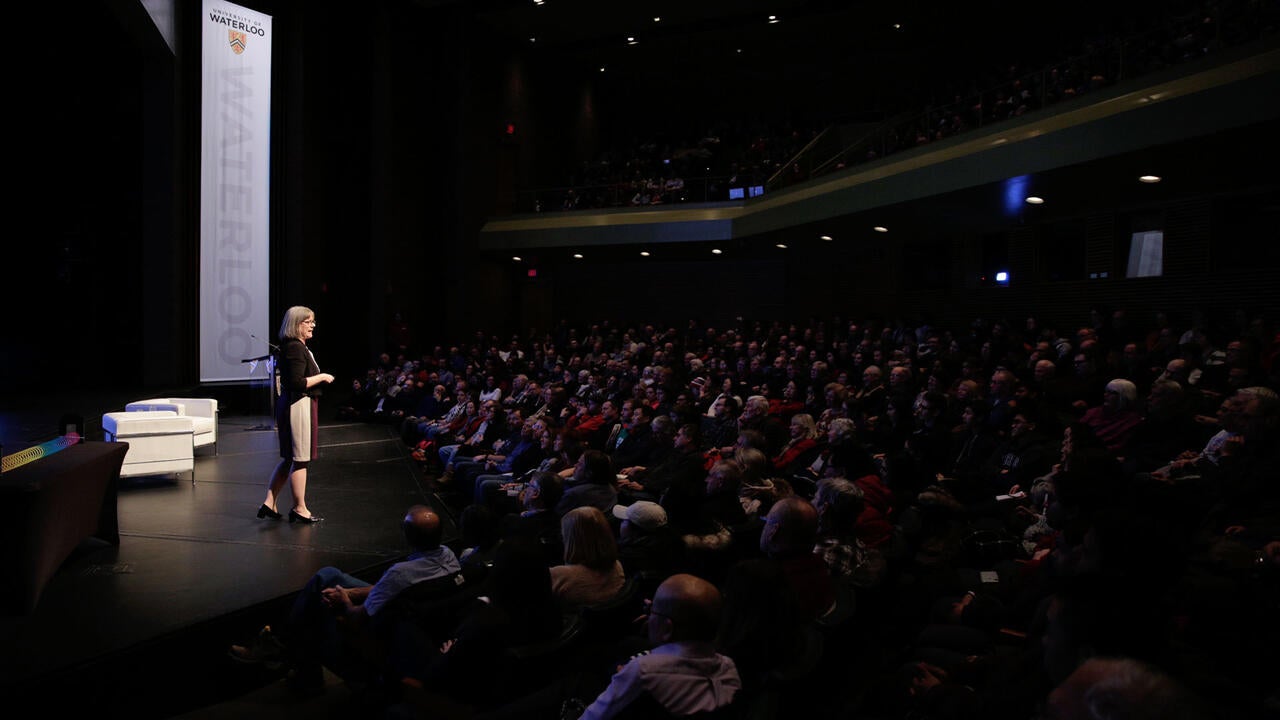
Strickland lecture highlights importance of fundamental research
Nobel laureate delivers first President's Lecture of 2019.

Nobel laureate delivers first President's Lecture of 2019.
By Pamela Smyth University RelationsFuture innovations rely on researchers doing basic science, Canada’s newest Nobel laureate told a near-capacity crowd during the President’s Lecture at the University of Waterloo.
Donna Strickland, a professor of physics at Waterloo, advocated for support of curiosity-driven research during a thought-provoking discussion with Kate Lunau, senior editor at Motherboard, VICE’s science and technology site. The fireside chat followed Strickland’s lecture.
“We can’t keep coming up with new applications if we don’t keep having a better understanding of the world around us,” said Strickland. “If we stop doing fundamental research, in 20 or 30 years we’ll run out of a bank of all of these ideas and it will be hard to move forward."
During Strickland’s lecture, she explained how she developed chirped pulse amplification (CPA), the research that won her a Nobel Prize in 2018. CPA enables the most intense laser pulses. Current applications include laser eye surgery and the machining of small, glass parts. But as Strickland indicated, she was trying to find out how high-intensity light affects matter.
“CPA came along not because we wanted to do new eye surgery. I was just trying to see can I get an atom to absorb nine photons or not,” she said. “It showed that actually the way we thought it would interact with matter was not how it interacted with matter and we had to rethink again how does light interact with matter. It was from that understanding that a whole lot of new things came along.”
When asked whether in Canada we are doing enough to support researchers conducting basic research, Strickland said the situation keeps changing. She referred to Canada’s Fundamental Science Review, also known as the Naylor report, a government-commissioned report from 2017 that examined funding for basic science in Canada. It calls for an increase in financial support for that research from federal sources.
“I think it did help convince the federal government that they were putting too much emphasis on industrially relevant research,” said Strickland. “A lot of that is short-term research and it’s not the long-term where you let us think about it for a few years and over the course of a PhD, flesh out an idea.” She added that the situation is improving somewhat, but that some other countries support it a lot more.
As the professor said in her talk, Albert Einstein created the equations for the three processes that go on in a laser in 1917, but there wasn’t until 1960 that there was a working laser. There was an amazing amount of work from a lot of different people between those two developments over years, said Strickland. Without them, the laser wouldn’t exist, and neither would the resulting nonlinear effects in use in so many ways today.
In his opening remarks for the event, Feridun Hamdullahpur, Waterloo’s president and vice-chancellor, stressed the importance of fundamental research, using Strickland’s results to help make his point.
“The whole world is benefitting from her curiosity,” he said.
Scientists are currently working on accelerating particles with the strongest CPA lasers. These particles might one day help surgeons reach tumours deep in the brain. CPA might also rid the Earth’s orbit of space junk by knocking the debris to the atmosphere, where it will burn up.
More than 700 people watched the lecture in person and online.

Read more
Here are the people and events behind some of this year’s most compelling Waterloo stories

Read more
Meet the five exceptional graduate students taking the convocation stage as Class of 2024 valedictorians

Read more
Meet the 13 exceptional students representing Waterloo’s newest grads
The University of Waterloo acknowledges that much of our work takes place on the traditional territory of the Neutral, Anishinaabeg, and Haudenosaunee peoples. Our main campus is situated on the Haldimand Tract, the land granted to the Six Nations that includes six miles on each side of the Grand River. Our active work toward reconciliation takes place across our campuses through research, learning, teaching, and community building, and is co-ordinated within the Office of Indigenous Relations.